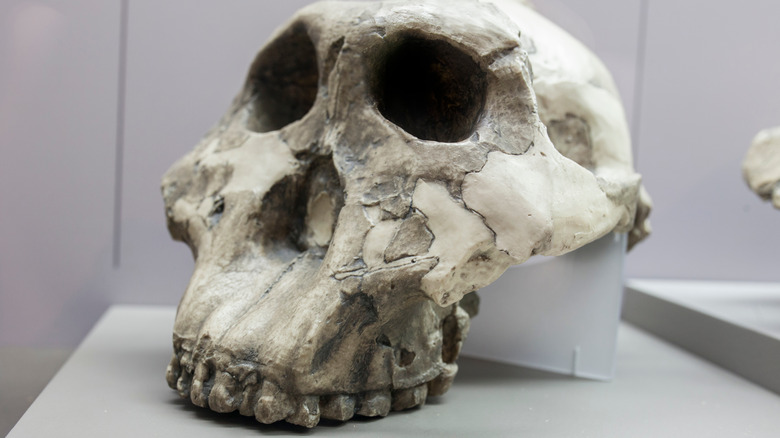
Gorodenkoff/Shutterstock
Homo sapiens, modern humans, or ancient human relatives belonging to the homo genus, may not have been the first of our ancestors to use tools, according to a 2023 study published in Science Magazine. These findings were based on the discovery on the shores of Lake Victoria in Kenya of a trove of so-called Oldowan stone tool kits dating to around 2.9 million years ago. Prior to that discovery, the oldest Oldowan tool kits — revolutionary technology at the time consisting of sharp-edged stone tools and other stone implements for large-scale food processing — were estimated to be around 2.6 million years old, as Reuters reports.
Those 2.6 million-year-old Oldowan kits were likely used by an extinct ancient human relative, Homo habilis, per the Museum of Anthropology at the University of Missouri. What's most remarkable, then, about the Kenyan research published in Science Magazine, is that no Homo sapiens fossils, which are only thought to have emerged around 300,000 years ago, nor any evidence of Homo genus relatives at all, were discovered alongside the Lake Victoria Oldowan tool kits. Instead, evidence uncovered suggests that a human-like primate relative, or hominid, may have used tools before Homo genus, which possibly upends accepted scientific conclusions on the development of stone tools and technology in human prehistory.
Paranthropus teeth were found

WH_Pics/Shutterstock
At the Lake Victoria dig, hundreds of Oldowan tool kits were found alongside hippo bones that showed signs that tools were used to process the hippo meat, based on CNN reporting. No evidence has been found to support early humankind cooking their food that far back, so hippo was likely consumed raw. Nor is it likely that the animals were hunted. While whoever used those Oldowan tools had some skill to cut and process meat, no implements have so far been found at the Kenyan site or any other site that could take down such large animals. Instead, it seems that the shores of Lake Victoria were where our ancient human relatives simply processed hippo, rich in fat and protein, after the animals died.
As well as tools and hippo, there were two teeth recovered from an ancient human-like ape called Paranthropus (skull pictured, above), a relative of modern humans from outside the Homo genus. This pushes the date of tool use much earlier than once thought and suggests that members of the Homo genus were not in fact the first hominids to use tools. Of the Kenyan study, professor of archaeology at the University of Southhampton in the United Kingdom, John McNabb, who was not involved in the research, told CNN, "This discovery means precision flaking techniques existed a lot earlier than we thought," with implications for hominid cognition and social development. "These are techniques you have to acquire somehow from other knapping hominins around you," Knapping refers to the process of making tools from stone or flint.
Mysteries remain as to precisely whom the tools belonged

frank60/Shutterstock
As Reuters goes on to note, though Paranthropus teeth were discovered alongside the Oldowan tools near Lake Victoria, with no evidence a member of the Homo genus was anywhere in sight, it's difficult to know for certain that Paranthropus in fact made and used the tools. On that note, study co-author and director of the Smithsonian National Museum of Natural History's Human Origins Program, Rick Potts said, "When our team determined the age of the Nyayanga evidence," Nyayange referring to the Lake Victoria site the tools were discovered, "the perpetrator of the tools became a 'whodunit' in my mind."
Potts continued, "There are several possibilities. And except for finding fossilized hand bones wrapped around a stone tool, the originator of the early Oldowan tools may be an unknown for a long time." Still, study lead author Thomas Plummer of Queens College in New York City said (via Reuters), "The association of these Nyayanga tools with Paranthropus may reopen the case as to who made the oldest Oldowan tools. Perhaps not only Homo, but other kinds of hominins were processing food with Oldowan technology," hominin referring to modern humans and extinct human ancestors who walked on two feet, hominids encompassing humans but also the full spectrum of great apes, as Science Learning Hub explains.